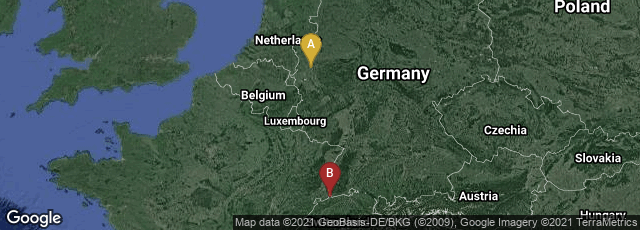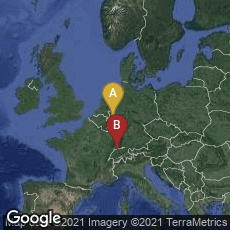

A: Stadtbezirk 1, Düsseldorf, Nordrhein-Westfalen, Germany, B: Basel, Basel-Stadt, Switzerland
In 1778 French architect and builder Nicolas de Pigage, and Swiss engraver, publisher and art dealer Christian von Mechel issued an oblong folio entitled La galerie électorale de Dusseldorff, ou, catalogue raisonné et figuré de ses tableaux dans lequel on donné une connoissance exacte de cette fameuse collection, & de son local, par des descriptions détaillées, & par une suite de 30 planches, contentant 365 petites estampes redigées & gravées d'après ces mêmes tableaux, part Chrétien de Mechel, Graveur a S.A.S. Monseigneur l'Électeur Palatin...Ouvrage composé dans un gout nouveau, par Nicholas de Pigage.... The work was published in Basel by Chrétien de Mechel (Christian von Mechel) and Les Inspecteurs des Galeries Électorales à Dusseldorff & à Mannheim.
As suggested on its title page, this innovative work was a revolutionary step in the history of museums, museum publications, and the art book. An illustrated catalogue of the magnificent art collection of Carl Theodor, Elector of Bavaria (1724-99), La galerie électorale de Dusseldorff, was the first publication to contain both illustrations and detailed descriptions of the artwork being recorded; “no other text describing in great depth the individual paintings in a gallery’s collection existed at the time” (Gaehtgens and Marchesano). The Elector’s collection of Italian and Flemish paintings, including a large group by Peter Paul Rubens (1577-1640), and other important paintings by Vandyk, Giordano, Tintoretto, Carracci, Veronese, Raphael, Corregio, Rembrandt and Reni, were reproduced in the catalogue by engravings showing the paintings in situ on the walls of the Dusseldorf gallery. These engravings, sumptuously printed on thick paper, illustrated the gallery’s innovative approach to staging its paintings: Not only did the gallery abandon the practice of hanging paintings frame-to-frame, “allowing them to preserve their identity as works of art in the space,” but “the principle of hanging paintings in a gallery according to decorative and representational considerations was abandoned in favor of a system of order determined by the history and significance of the artwork themselves, resulting in a history of art” (Gaehtgens and Marchesano, p. 31). The Elector’s gallery can thus be seen as an important ancestor of the modern museum, and its catalogue as a forerunner of the modern museum catalogue. The allegorical frontispiece by Nicolas Guibal includes a portrait of Prince Elector Johann Wilhelm von der Pfalz, the founder of the art collection. Gaehtgens and Marchesano, Display & Art History: The Dusseldorf Gallery and its Catalogue (2011).